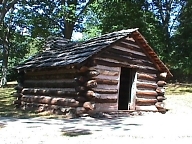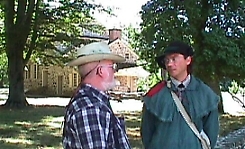A Winter at Valley Forge
Valley Forge National Park
Valley Forge, Pa.
August 2nd, 1999
As  we travel
through this land, looking for its history, we could not pass up
an opportunity to stop at one of the high points in the beginning
of our country. The year was 1777, The United States had existed
for only a year. The Continental Congress had established itself
in Philadelphia. General Washington found himself in command of a
undisciplined and untrained army made up of brigades from the
different States, each with its own commander. It was not an
army without experience. It was fresh from the disastrous attempt
to stop the British from taking Philadelphia at the battle of
Brandywine and later at Georgetown. Philadelphia had fallen and
the Congress had fled to York. The summer's campaigns had left
the Continental Army short on food and supplies. Washington made
the decision to dig in for the winter just 18 miles out of
Philadelphia on the Schuylkill River in an area named for an iron
forge on Valley Creek nearby. Thus began the famous winter at
Valley Forge. Washington rode into Valley Forge
we travel
through this land, looking for its history, we could not pass up
an opportunity to stop at one of the high points in the beginning
of our country. The year was 1777, The United States had existed
for only a year. The Continental Congress had established itself
in Philadelphia. General Washington found himself in command of a
undisciplined and untrained army made up of brigades from the
different States, each with its own commander. It was not an
army without experience. It was fresh from the disastrous attempt
to stop the British from taking Philadelphia at the battle of
Brandywine and later at Georgetown. Philadelphia had fallen and
the Congress had fled to York. The summer's campaigns had left
the Continental Army short on food and supplies. Washington made
the decision to dig in for the winter just 18 miles out of
Philadelphia on the Schuylkill River in an area named for an iron
forge on Valley Creek nearby. Thus began the famous winter at
Valley Forge. Washington rode into Valley Forge on December 19, 1777, with twelve thousand troops, a few dozen
cannons and not much more. Within days, the waters of the
Schuylkill river were frozen and six inches of snow lay on the
ground. The army, organized according to their brigades, set about
building what would finally be over a thousand huts. While
wandering the grounds in the warm sunlight of August, it was hard
to picture the cold and wet of the winter. To imagine thousands
of men huddled in these little huts for months on end. It fell to
the individual states to support their own brigades, so those
furthest away such as the Carolinas suffered most while the
Pennsylvania brigade fared much better. Food, clothing, shoes and
blankets were always in short supply. Cold and hunger prevailed
throughout the winter. Illness quickly spread through the cramped
quarters filled with weakened men. Soon the
on December 19, 1777, with twelve thousand troops, a few dozen
cannons and not much more. Within days, the waters of the
Schuylkill river were frozen and six inches of snow lay on the
ground. The army, organized according to their brigades, set about
building what would finally be over a thousand huts. While
wandering the grounds in the warm sunlight of August, it was hard
to picture the cold and wet of the winter. To imagine thousands
of men huddled in these little huts for months on end. It fell to
the individual states to support their own brigades, so those
furthest away such as the Carolinas suffered most while the
Pennsylvania brigade fared much better. Food, clothing, shoes and
blankets were always in short supply. Cold and hunger prevailed
throughout the winter. Illness quickly spread through the cramped
quarters filled with weakened men. Soon the makeshift hospitals were filled to capacity. There was no
medicine and few to care for the sick. Many considered being
taken to the hospital a one way trip. By the end of the winter
over 2000 of his men has perished from malnutrition and disease
and another 4000 had deserted. The few scattered farm houses in
the area were converted to military use, with Washington setting
up his headquarters at the Issac Potts House. The modest two
story stone building stands today as a museum to the Military
commander it served. We strolled through the park surrounding the
house trying to picture the hustle and bustle of a headquarters
piled with snow all around. The rooms are laid out much as they
would have been during that winter. From here, Washington planned
to hold his band of untrained farmers together until
makeshift hospitals were filled to capacity. There was no
medicine and few to care for the sick. Many considered being
taken to the hospital a one way trip. By the end of the winter
over 2000 of his men has perished from malnutrition and disease
and another 4000 had deserted. The few scattered farm houses in
the area were converted to military use, with Washington setting
up his headquarters at the Issac Potts House. The modest two
story stone building stands today as a museum to the Military
commander it served. We strolled through the park surrounding the
house trying to picture the hustle and bustle of a headquarters
piled with snow all around. The rooms are laid out much as they
would have been during that winter. From here, Washington planned
to hold his band of untrained farmers together until  spring
when he knew he must face and defeat the professionally trained
British army or watch the colonies be forced back under British
rule. The situation was desperate, the prospects bleak, when,
into the midst of the misery rode one of America's unsung heroes.
On a cold February morning, the tall Prussian officer stood
before Washington with a letter of introduction signed by
Benjamin Franklin. He had been a one time member of the General
Staff of Frederick the Great, king of Prussia, but had found
himself unemployed in France when Ben Franklin talked him into
joining the Continental cause. Fredrich Wilhelm von Steuben
brought with him a wealth of knowledge which Washington saw as a
possible answer to one of his biggest challenges. He immediately
appointed von Steuben acting Inspector General with he task of
developing an effective training program. Numerous obstacles
threatened success. No standard American training manuals existed
and von Steuben himself spoke little English. Undaunted, he
drafted his own manual in French, His aids often worked late into
the night translating his work into English which in turn was
passed out to the individual regiments.
spring
when he knew he must face and defeat the professionally trained
British army or watch the colonies be forced back under British
rule. The situation was desperate, the prospects bleak, when,
into the midst of the misery rode one of America's unsung heroes.
On a cold February morning, the tall Prussian officer stood
before Washington with a letter of introduction signed by
Benjamin Franklin. He had been a one time member of the General
Staff of Frederick the Great, king of Prussia, but had found
himself unemployed in France when Ben Franklin talked him into
joining the Continental cause. Fredrich Wilhelm von Steuben
brought with him a wealth of knowledge which Washington saw as a
possible answer to one of his biggest challenges. He immediately
appointed von Steuben acting Inspector General with he task of
developing an effective training program. Numerous obstacles
threatened success. No standard American training manuals existed
and von Steuben himself spoke little English. Undaunted, he
drafted his own manual in French, His aids often worked late into
the night translating his work into English which in turn was
passed out to the individual regiments.  As
we passed to the rear of the house we met Marc Brier, dressed in
the traditional uniform of the Continental soldier. He explained
that "Von Steuben even shocked some of his fellow officers
when he hand picked 100 men from the field to personally train as
a unit." This unit quickly became the model by which other
training was measured. Day and night, von Steuben's commanding
voice could be heard in camp, directing, correcting and
re-directing. As regiments and then brigades began to pull
together in a single fighting force, pride and enthusiasm
re-emerged among the ranks and spirit of the army was rekindled.
As spring arrived new supplies and more men poured into the
valley and there was now a new alliance with France to bolster
their flagging spirits. On June 19, 1778, Washington marched out
of Valley Forge in search of the
As
we passed to the rear of the house we met Marc Brier, dressed in
the traditional uniform of the Continental soldier. He explained
that "Von Steuben even shocked some of his fellow officers
when he hand picked 100 men from the field to personally train as
a unit." This unit quickly became the model by which other
training was measured. Day and night, von Steuben's commanding
voice could be heard in camp, directing, correcting and
re-directing. As regiments and then brigades began to pull
together in a single fighting force, pride and enthusiasm
re-emerged among the ranks and spirit of the army was rekindled.
As spring arrived new supplies and more men poured into the
valley and there was now a new alliance with France to bolster
their flagging spirits. On June 19, 1778, Washington marched out
of Valley Forge in search of the  British. He found Lt. Gen. Sir
Henry Clenton's British forces at Monmonth in New Jersey. The
report of some local rebel-rousers approaching brought smiles to
the British officers faces, but these
smiles quickly faded as they saw the snappy formations of
regiments quickly moving into formation. As the battle concluded,
only the American officers were smiling. The British had lost the
day, as they would eventually lose the war. The turning point in
this most significant part of American History was the lessons
learned while suffering the winter at Valley Forge.
British. He found Lt. Gen. Sir
Henry Clenton's British forces at Monmonth in New Jersey. The
report of some local rebel-rousers approaching brought smiles to
the British officers faces, but these
smiles quickly faded as they saw the snappy formations of
regiments quickly moving into formation. As the battle concluded,
only the American officers were smiling. The British had lost the
day, as they would eventually lose the war. The turning point in
this most significant part of American History was the lessons
learned while suffering the winter at Valley Forge.
* * * THE END * * *